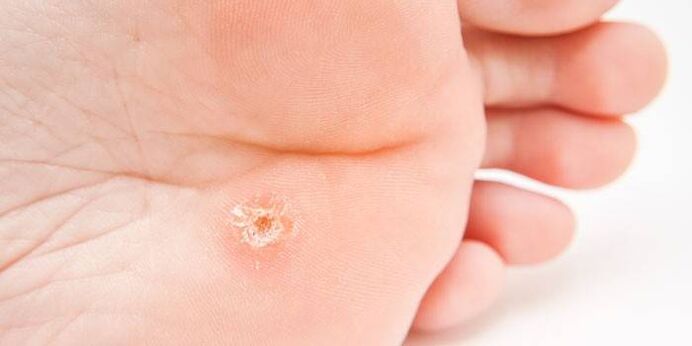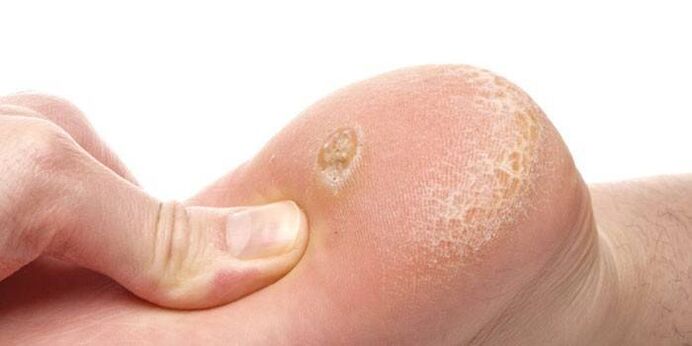Since ancient times, mankind has been disturbed by ugly formations on the body. Warts on the feet are a skin disease caused by a virus. People with skin defects were avoided for fear of infection and tried to remove the lesion on the sole or other part of the body as soon as possible. What do people not apply to their plantar warts, if only they disappear forever. To date, dermatologists are looking for the most effective and painless method to fight the disease.
What is a wart
The human papillomavirus provokes a benign or oncological DNA mutation in skin cells. The body is covered with papillomas, warts, papules. More than a hundred types of HPV have been studied. Warts are skin growths that indicate the presence of the first or third type of papillomavirus in the body. The neoplasms are potentially non-carcinogenic but highly infectious because the pathogen is viable in the external environment.
What does a wart look like on your feet?
The plantar neoplasm has a round shape with clear edges that are a few millimeters or centimeters in size. The black dots of clogged capillaries are visible in the center. On the foot, they look like old, dry stones that have grown into the skin. The pain from plantar growth is not manifested by direct pressure, but by compression. Typical lack of papillary lines on the foot.

Causes of plant warts
HPV infections are more common during unprotected sex. The virus enters the mucous membranes of the genitals through microcracks. Some people are "in transit" for HPV, but others are less fortunate - the virus lingers in the body without being notified for a long time. Dermatologists do not rule out the possibility that papillomas appear on the surface of the feet due to immune system disorders and infectious diseases.
Walking barefoot in public places: baths, swimming pools, body salons, shared bathrooms, on the beach, wearing shoes barefoot are the most common causes of plantar warts. The virus is viable outside of its host and "waiting for a victim" on towels, tiles, rags, furniture, slippers, etc. The infection is caused by tight, tight areas on the skin of the feet and hands where the papillomavirus enters with minor injuries.
Warts on children's feet
Children are restless, often injured. Parents may not be aware of the presence of HPV in a child's body due to cuts or abrasions. When the immune system is weakened, the virus becomes active and a papilloma appears on the leg. Painful methods of dealing with warts on the feet in children are often contraindicated and poorly tolerated. Often a child's body copes with this skin condition on its own.
Types of warts on the feet
Warts are a collection of skin lesions caused by papillomas. The following types of warts are classified as having an effect on human health, depending on their appearance:
- vulgar (usually) - round keratinized blisters;
- flat - rash in the form of spots that rise above the skin;
- filiforms (acrohords) - stretched with "torn" edges, formed in the folds of the body;
- genital warts - reminiscent of a rooster comb;
- senile (keratomas) - occurs in the elderly, not related to HPV.
Wart formations are localized throughout the body, on the internal organs, in the oral cavity. Warts on the feet, called plantar warts, are a common type. One type includes well-formed depressions that are characterized by rapid growth. The appearance of subungual growths slightly raises the nail plate.

Treatment of plantar warts
It is dangerous to neglect the treatment of plantar warts. Neoplasms on the legs are constantly injured. They are removed to stop the growth of new growths and infections. There is no complete cure for HPV. Treatment is reduced to turning the disease into "sleep mode". Pharmacological, surgical, immunomodulatory removal of plantar warts using alternative medicine is available.
The disadvantage of treating the growth of plants is their location: the large layer of the epidermis makes it difficult to deliver the active substances to the depth of the foot. In preparation for therapy, the top layer of the formation is soaked and peeled. Traditionally, the treatment of warts on the legs begins with the use of salicylic acid. The wart on the foot every day for three months, steamed in a bath, disinfected, then with a pumice stone clean the softened surface, apply salicylic acid, apply a patch.
Pharmacy chains advise on how to get rid of warts on the feet using drugs that contain celandine, phenol, trichloroacetic acid. The drug causes tissue necrosis, relieving the patient of the deficiency but leaving traces of deep wound healing. Each disease is individual in varying degrees, so before choosing a method to remove warts on the soles of the soles, you should consult a doctor.
Ointment
According to the method of action are necrotizing, antiviral, vegetable ointments. In the first case, the acid or alkali at the base of the ointment cauterizes the painful growth and leaves a scar. At home you can use liquid solutions for the treatment of feet: with acetic acid, nitric acid, oxalic acid, lactic acid. The surface of the neoplasm is rigidly treated to avoid burns.
Antiviral ointment for warts on the feet is applied to and around the growth site itself to reduce the spread of the infection. They are used in conjunction with special ointments. Herbal ingredients only affect the formation of the skin. Known for its effectiveness in the treatment of foot balm with an applicator, colhamin ointment.
Modern removal methods
The advent of modern wart removal methods has replaced the traumatic scalpel. Like a surgeon's knife, an electrocoagulator burns the neoplasm of the foot with electricity. After the removal procedure with a laser or radio waves, the foot remains depressed. Healing lasts for several weeks. Exposure to liquid nitrogen is considered a very painful treatment and requires several procedures. In 2014, British dermatologists published material on the latest in antigen injection therapy. This will help patients who are resistant to existing treatments.

Folk remedies
Folk remedies for warts on the feet are performed before going to bed, with pre-steamed feet and for a long time. During handling, protect your hands with latex gloves from further spread of the infection, disinfect all used equipment and items to prevent contamination of relatives. A list of popular folk remedies to get rid of warts:
- Garlic is known for its antibiotic properties. In the neoplasm, the upper hardened layer is cut off on the sole, a thin clove of garlic is applied.
- You can make a "beard dough". It is kneaded from finely grated garlic, vinegar, wheat flour, spread on a neoplasm surface and sealed with plaster. After a few days, the dough is removed along with the accumulation.
- Apply to the foot onion infused with vinegar, or you can rub the growth with vinegar, then add fresh onion.
- The formation can be filled with herbal juice: celandine, calendula, calendula, milk thistle, dandelion, golden mustache, or add a slice of apple, mountain ash, figs, potatoes, horseradish, cabbage. The procedure is performed daily, it lasts from several weeks to months, until the accumulation disappears.
- You can apply the wood ash diluted in water to a creamy state.
- Sprinkle the growth with powdered chalk and wrap with a bandage. The compress cannot be moistened.
- Birch and willow bark containing salicyl have proven to be good in treatment. The bark is applied to the foot, previously softened with boiling water.
- Hot foot baths with sea salt, soda, laundry soap, tea tree oil or spruce broth help treat foot ailments. Treatments can be mixed or alternating.
- Use wormwood broth applications. 3 tablespoons of dry wormwood herbs boil in a glass of boiling water, insist for at least 2 hours.














































































